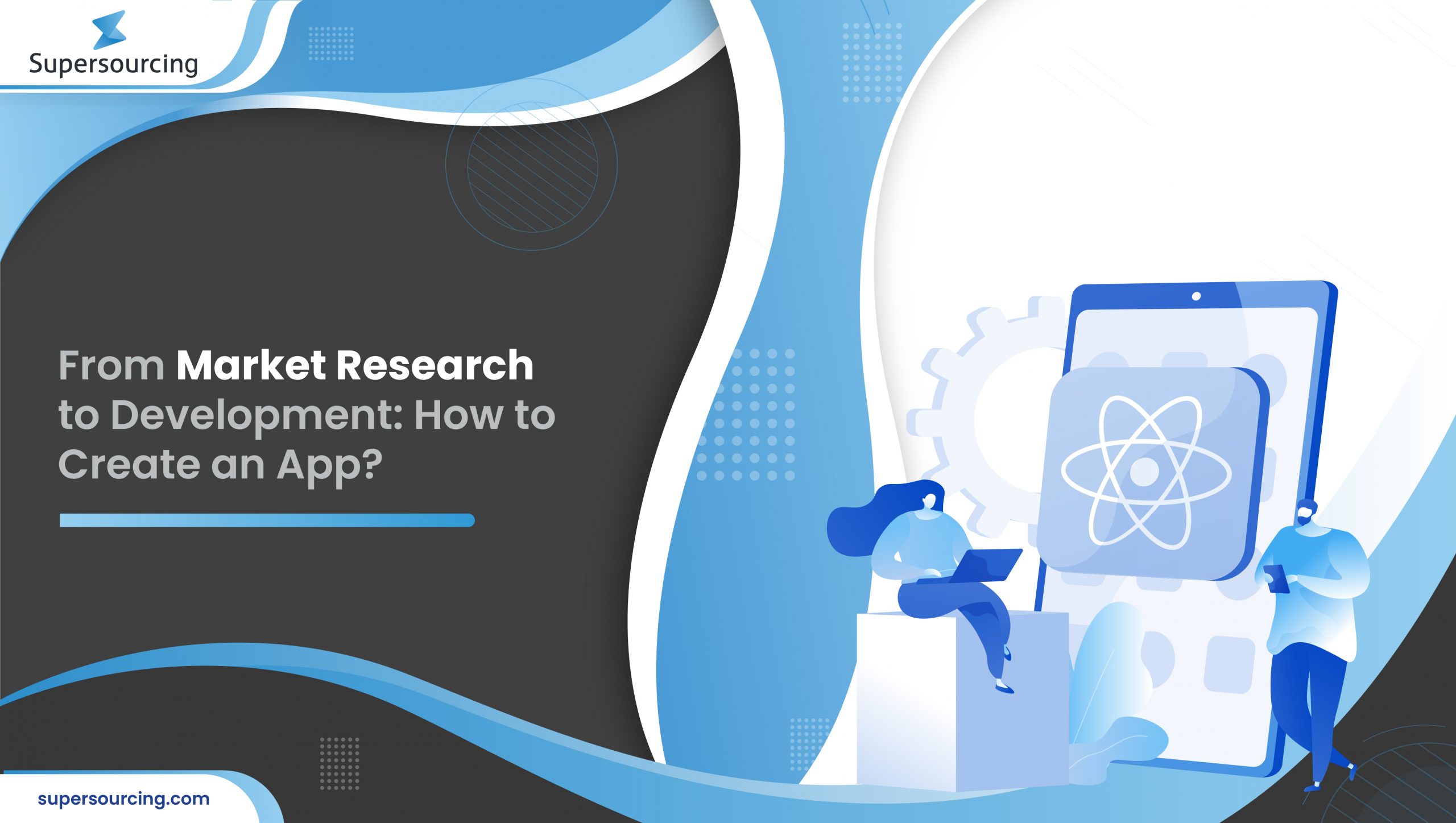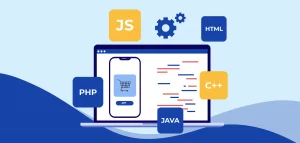Table of content
For many, the possibility of developing a smartphone app from scratch
seems to be an intimidating challenge replete with complicated coding
tasks and lots of market research. However, this does not have to be the case! So for simplification,
you must first design a new smartphone app before creating it. It’s
important to schedule every move, and you might want to take a break
from time to time to reflect on what you’re doing.
If you’re in a customer-first company (which is any business), you need
a smartphone app. It is no longer an alternative, but rather a
prerequisite now. Global app installs are forecast to hit 258 billion by
2022. Businesses who made the error of not developing a smartphone app
would struggle in the coming years as well. What reason would the
company have for not offering a smartphone app because the regular
person spends more time staring at a mobile screen than watching TV or
using a monitor or a laptop?
Step from Market Research to Development: To Create an App
developing an app
for your business.
1. Brainstorm for a Right and Workable Idea – Ideation Stage is
Important
Anything begins with an idea. The first and most important step is to
develop your idea into a solid foundation for the application.
- Begin by including the whole team in the process.
-
Invite all staff members to a team workshop is an excellent
opportunity to mix 360-degree concepts. In this plenary conference,
app creators can take centre stage. -
The majority of the team can be highly innovative, but it is the
programmers that have a special insight into app development.
There hasn’t been a team that hasn’t seen an anecdote regarding the gap
in concept goals and facts from people who aren’t in the niche!
Ideation workshops stand out as unmistakably innovative gatherings. At
the very least, you won’t see two-thirds of your coworkers with one leg
out the door!
-
Keep in mind that you would need to invest some time planning the
workshop before running it. -
Concentrate on assisting the team in remaining focused on the job
at hand and resolving the issue. - Set up the room and include the analysis results.
-
After that, you will continue the ideation phase by exploring some
of the user personas and the issue in greater depth.
Set a time challenge to heat up the environment. If you haven’t learned
of the Pomodoro method, now is a good time to start. Conduct 20-minute
sessions and don’t waste too much time at the outset, searching for
weaknesses. Therefore, simply kickstart the concepts and enable them to
snowball into improved iterations in the subsequent timed
sessions.
2. Market Research Thoroughly
Market research
is often overlooked by app developers, despite it being an essential
component of developing an app. By doing preliminary testing, you can
save time and money later on.
Everyone wants to know if the app concept is feasible or not. So raise
questions like:
- Who are the other players and applications in the market?
- What do prospective consumers desire?
- What are their wants and needs?
- How to make a successful business model?
- What price can I set for my app?
Performing market research
before developing the app will help you avoid making costly errors early
on because you validate conclusions and determine potential customers’
expectations.
Two forms of market research
are particularly useful:
- Identifying the blunders that your opponents are making.
-
Determining whether or not users are searching for an app close to
yours.
You can predict the need for an app without even developing it. To
gauge interest in your app, use Google Trends and Keyword Planner. To
perform market research, use Google Trends.
Finding insights has another function as well; you ought to put
yourself in the shoes of your consumers. You tend to go out there and
speak to others instead of staying safely in front of your screen,
evaluating needs and expectations.
- Who is your app intended for?
- What are their personalities like?
-
How does the app affect a specific challenge that people are
experiencing? - How are they currently addressing the issue?
- What difference do you hope to create for your app?
Depending on your analysis, you should be able to specifically identify
the issue that the app solves and who it solves it for. You can use
these experiences to build a great app for your customers.
-
Time:
Spend a few days exploring to make space for proposals. -
Cost: You can do this for free or by investing in professional
tools.
Often what you want to do is build an app for yourself. And that’s
fine! You should conduct research for the sake of learning and
practising your trade and then design your app as you see fit. But don’t
neglect the value of planning, research, and insight.
3. Know Your Audience Well
A well-defined target audience is critical since it serves as the basis
for your design, production, and marketing strategy.
Having a target audience entails investigating the intent of the app
and the problem it is attempting to solve. Then, consider who will be
interested in using your app. Having a good view of your target
demographic helps you create user-centric features and designs. In terms
of marketing, you’ll recognize how to hit your target audience. You must
figure out what social networks they use, what subjects they look for on
the news, and what publications or programs they follow based on the
knowledge you’ve collected. The target demographic is an important
consideration when it comes to attracting and retaining the correct
audience for your app.
A target audience includes the following demographics:
- Age
- Gender
- Location
- Language
- Education
- Occupation
- Marital Status
- Familial Status
- Interests
- Devices
Psychological demographics for a user persona includes the
following:
- Personality
- Values
- Behavior
- Habits
4. Do a Competitor Study
Conducting a competitors
analysis
aids in the creation of app project specifics that are more likely to be
effective, providing companies with a good picture of the competitive
environment. The market research
through a comparative analysis enables wise, measured, and reliable app
product choices. Thus, competitors analysis
involves the following stages:
1st Stage:
Determine your distinctive value proposition.
2nd Stage: Study the competition.
3rd Stage:
Build a competitive analysis matrix for your app.
4th Stage:
Investigate your competitor’s digital strategy.
5th Stage:
Examine the app store ratings, rankings, and reviews of
competitors.
6th Stage:
Evaluate the needs of the target group.
7th Stage: Examine the app market.
5. Create Basic Wireframes
Wireframes are the foundation of every project, even mobile app design.
Basically, wireframes work as a bridge between low-fidelity drawings and
early immersive experiments. Therefore, the real method of mobile
wireframing differs greatly.
Wireframing and its translation to hi-fi architecture were approached
differently by various artists. Although certain businesses argue for
moving straight to code from drawings, the standard design procedure
includes the following steps:
1st Step: Sketch (Conceptual level)
2nd Step: Wireframe (Component level)
3rd Step:
Mock/Mobile App Prototype (Styles level/Interactions level)
4th Step: Code
Steps for Wireframing a Mobile App
Follow these steps for creating the mobile app wireframes:
- Begin by visualizing the desired user flow.
- Create a rough sketch of the user flow.
- Begin wireframing by establishing a Mobile Frame.
- Using boxes, determine the layout.
- Make use of style trends.
- Bring in the actual copy.
- Check to see how the output scales well.
- Connect the pages to generate a flow.
- Put the design choices to the test.
6. Find a Development Partner
In an environment of fierce rivalry and fast market expansion, a strong
app development
partnership will save your life. Where can you look for a development
partner? You should search for a development partner by doing the
following:
- Analyzing your network
- Asking for recommendations
- Going online
- Visit an event – IT conferences or a startup meet
7. The UI/UX Phase
Often developers build an app that performs well but fails to
concentrate on design, which contributes to the app’s demise. The
compromise between an app’s functionality and
UI/UX design
is difficult to maintain; however, it is essential. When designing the
UI/UX of mobile applications, there are a few main components to keep in
mind.
a. Information Architecture (IA)
The aim of IA is to provide users with a simple way to navigate,
regardless of which browser they are using. It largely revolves around
supplying them with an excellent navigation experience.
b. Interaction Design
This is the process of developing a conceptual design that would
allow consumers to communicate with the app. Colors, aesthetics,
symbols, fonts, photographs, and so on are all part of it.
c. Usability
This section of the mobile app design principles is concerned with
determining whether or not consumers are receiving the details they
need by the usage of the application and whether or not the app
provides them with a self-serving method to manage problems.
d. Wireframe
The development of an app’s demo for the purpose of checking
functionality, performance, and the look of the app before it goes
live in the market is all part of the user experience design for
mobile apps.
e. Visual Design
It all comes down to defining the app’s brand in the eyes of the
users. It is not only about selecting the right colors, icons,
pictures, fonts, and so on, but also about its presentation, which
can have an effect on users at various stages of their
interaction.
8. Testing
You can’t wait to release the freshly developed app, but without
checking its functionality is a no-go since the overall failure rate for
app testing for Android is 16.4%. The aim of mobile application
testing
is to guarantee that there are no glitches and that the app functions as
intended. Thus, an app testing phase consists of many phases. This sort
of thorough monitoring would make sure that your app runs
smoothly.
There are many types of mobile
application testing, and a good solution is to screen with all of them.
- Functional Testing
- Memory Testing
- Performance Testing
- Security Testing
- Interruption Testing
- Usability Testing
The app may be reviewed internally, externally, or by the developers
themselves. However, it is advised that the people who are testing the
app shouldn’t be your developers or their collaborators.
9. Launch and Market the Product
A mobile app marketing strategy’s awareness stage begins before the
application is released. This stage is intended to increase brand
recognition and product exposure.
a. Choose a Release Date
Planning ahead of time will provide you ample time to prepare for
your product’s hard launch and will help you to predict and plan for
any contingencies that could arise. When deciding on a launch date,
consider activities in your area that have the ability to overshadow
your app’s launch.
b. Make a Website or a Landing Page
The most common source of app installs is mobile websites.
Therefore, creating a pre-launch landing page or, at the very least,
a promotional video for the product has become an industry norm. If
you’ve created a video for your page, you can repurpose it by
putting it in app stores, social media sites, or even paid
advertisements. A pre-launch website is a perfect opportunity to do
some early Search Engine Optimization (SEO) by beginning to create
your domain authority, in addition to creating buzz about your app.
Collect emails as you set up your website so you can keep your fans
posted and let them know when your mobile app releases, as well as
when you have new changes and features. It is also helpful to
display 5-star ratings on the site; nevertheless, make sure the
reviews are genuine; otherwise, the brand will seem insincere.
c. Outreach Initiatives
Outreach campaigns, such as targeting influencers, publications,
and blogs to obtain backlinks and have truthful feedback, are one of
the most underestimated facets of selling a new smartphone app. Make
a list of friends in your business or niche who might be involved in
writing about and evaluating your app. Keep your pitch brief and
have a connection to your press kit or landing page.
d. Promote on Social Media
Facebook, Instagram, Twitter, LinkedIn, Pinterest, and other social media enable you to broaden your web presence and
engage directly with your target audience. Therefore, if your app is
aimed at a particular age group, recognize and rely on the social
media that are more common with this audience.
Conclusion
App creation is a continuous phase and can begin beyond the initial
launch as you gather input from users and introduce new features. So,
spend time checking the app’s performance, keeping your UI up to date,
ensuring it supports the newest tech, fixing glitches, and introducing new
functionality regularly to make it a success!
To build such quality apps with a lot of brainstorming and research work
then Supersourcing
can be the most appropriate platform for you. Therefore without much a do, share your business idea with us
and we will help you to get the expert and experienced team in the
respective domain to take your business live.







